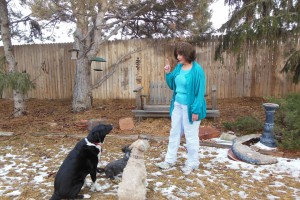Dogs can be our best friends, can prolong life, and help with psychological problems. Some even find lost kids or track down criminals. But a lot of what they do depends on us. Here’s what to know about dogs.
One in three of us in the U. S. owns at least one dog. More than 70 million of these complex creatures live in 43 million American households according to the American Veterinary Medical Association. With so many dogs in our midst, it pays to be smart about them.
Animal behaviorist and dog trainer Sunny Weber is making it her life’s work to educate people about pet ownership.
“Owning a dog is a major responsibility. Dogs require training, attention, time, space, emotional availability, food, water, exercise, and understanding.” Weber said. “You need to share a large part of your life in your relationship with your dog.”
Weber should know. She has been studying, training, and taking care of dogs professionally for 25 years.
“I’ve taken national and local seminars, had mentors, studied animal behavior, read endlessly, spent years in hands-on contact and also believe I was gifted with a lot of instinct when it comes to animals,” she said.
An active and sought after consultant for shelters, rescues, and sanctuaries around the country, Weber is also a professional humane educator for schools and community groups. “Education about pets can save pet’s lives. And also make the owner’s more pleasant,” she said.
According to Weber, some of the biggest mistakes dog owners make is adopting or buying a dog on impulse because the dog is cute or you want companionship, not thinking through all the details of what a dog needs.
There were no available statistics on how many people who live alone own dogs. If you are solo, however, you might be tempted to get a dog for companionship, or the excuse to take a walk or visit a dog park to meet other dog owners. Without someone to share the responsibility with, that’s all the more reason to assess your lifestyle and resources before you take on dog ownership.
Getting a dog? Weber’s advice on what to know about dogs
- First, beware of online and pet shop purchases. Most of these operations are fronts for inhumane “puppy mills” and if they do deliver a dog, many animals have behavioral, medical, and temperament issues due to mass breeding and poor conditions. It is always best to adopt from a qualified (501-C-3 non-profit) shelter, rescue, sanctuary or a certified breeder.
- Be prepared for a life-long commitment. Small dogs can live as long as 15-18 years, medium breeds 10 to 15 years, large breeds 7 to 12 years, giant breeds 5 to 9 years. Your relationship with your dog will be long-term.
- Research various breeds to see which fit best into your home, time schedule, and lifestyle. If you’re a neatnik, don’t get a Great Pyrenees. If you dislike dirty paw prints, you may not want a dog at all – an indoor cat might suit you better.
- Know that all dogs need and deserve protection from the elements, good food, clean water, space to move, medical care, companionship, intellectual stimulation, and above all, training.
- Understand the financial commitment – for food, grooming, veterinary fees, medications, boarding if you travel, equipment like collars, leashes, and bedding. The initial purchase or adoption price is just the beginning.
- Consider the individual dog’s energy level. Try to match the dog’s energy to your own. If you’re a couch potato, don’t get a Border Collie. If you like to hike, don’t get a Chihuahua.
- Learn the psychological processes of dogs so you can address their emotional and cognitive needs in addition to the physical. For example, herding dogs are highly inquisitive and intelligent, terriers are territorial and vocal, small breeds are cute companions but need constant attention.
- Make sure you understand that dogs are pack animals and need to be secure in their family unit position. You must be prepared to be a firm but benevolent leader and provide consistent household manners training.
-
Dogs require your emotional availability – you become the reason for their being. Dogs are not emotionally or cognitively developed for isolation so don’t expect yours to be happy alone for extended periods of time. You become their pack mate so companionship is crucial to avoid behavior issues.
- Plan to train, play, and share activities with your dog and also provide some interaction with other dogs.
“Many people don’t think it all through when they get a pet and are surprised when the animal becomes sick or needs expensive medical care, especially as he or she ages. It’s not uncommon today for veterinary care, operations, and long-term medical conditions to cost upwards of $10,000,” Weber said. “There’s nothing more heartbreaking than not being able to provide needed medical care because of cost. And there’s nothing more cruel than to abandon an old friend in a shelter because you don’t want to deal with the infirmities of old age and frailty. That’s why I encourage people to be thoughtful about deciding to get a dog as a pet.”
Avoid this – what to know about dogs
Unfortunately, not all 43 million U.S. homes are happy ones for dogs. Or for people.
In the U. S. alone, there are 4.7 million dog bites a year, many severe. And about 4 million dogs are abandoned each year in the U. S. according to Animal Rights Action.
“Some people may get a pet for the wrong reason or not train it or treat it properly. These things lead to behavior problems, especially around other people. So it’s important to know how to behave around dogs you don’t know,” Weber said.
Weber’s Tips on Encountering Strange Dogs
- Look at their body language. Check for a relaxed face, loose body, “smiling” tongue lolling, a bow as an invitation to play.
- Friendly dogs take a curved approach to other dogs, they circle them, then approach and sniff and often go off and pee together. A friendly dog will approach you the same way (although you won’t be expected to pee on a bush!).
- Unfriendly dogs come straight on, with a stiff body, tense closed face, closed mouth, or their hair standing up. Wagging tails are deceptive, watch the whole body.
- When a strange dog approaches you, stop and stand still, let the dog approach you, don’t approach it.
- Don’t make direct eye contact, look toward the dog but not in its eyes. Eye contact is seen as a sign of aggression and you don’t want to be perceived as aggressive toward the dog.
 Don’t smile – when dogs show teeth it’s a serious warning. You don’t want to appear threatening.
Don’t smile – when dogs show teeth it’s a serious warning. You don’t want to appear threatening.- Turn sideways, so you’re not straight on. This is neutral body language.
- Soften your body posture, round your shoulders. Speak in a high-pitched voice. It’s as attractive to dogs as singing.
- Let the dog sniff your feet and legs.
- Don’t bend over the dog, bending can be perceived as domination. It also puts your balance at risk – a dog that jumps up to “kiss” or bite can easily knock you backward. Standing sideways plants your feet so you can’t fall over.
- Never pat the top of the dog’s head, but you may scratch it under the chin, on the shoulder or the chest. All animals are “head-shy” with people they’re not familiar with. Plus if a dog is so inclined, a hand over its head is vulnerable to a quick snap or solid fear-based bite.
- Never corner a dog. If he’s uncomfortable with your presence, he’ll leave and he should have a route to avoid you. Never confine a dog – especially in a hug.
- If the dog seems unfriendly, growls, or shows threatening body language, remain still, make yourself as big as you can be by widening your arms and legs and raising your head. Don’t stare at the dog. When the dog loses interest, back away from the dog slowly. Never turn your back and never, ever run away from any dog.
The Voice of Experience
Weber is not only a dog expert, she’s also a dog lover. She owns three – Jessie is a 10-year-old Lab mix who at the age of two was scheduled for euthanasia for destructive behavior. Weber fostered him, worked with him, fell in love with him and kept him. Bailey, an eight-year-old Wheaton Terrier was also a behavior foster. Bailey faced euthanasia due to her intense and irrational fears and phobias. Weber decided to keep her when she bonded to Jessie – and Weber bonded to her. Brillo, a little five-year-old personality-plus Lhasa mix came for medical rehab with a broken back and leg. Now she also has a nurturing home with Weber.
One of Weber’s businesses is Manner for Mutts and Kitts. She does house calls to dog and cat owners and helps them with problem-solving behavior advice. She also “baby-sits” special needs dogs and cats (ones that are either a bit ill or have some behavioral problems) in her home which is designed for pet care.
Solo Weber explained that because she has her own “pack,” she has a certain protocol for accepting dogs. First she takes her dogs to meet the possible boarder to “neutral territory” to assess their greeting patterns (what else? smelling and peeing – smelling is equivalent to our human handshake, she said), then if all goes well, she takes them into her backyard to observe the interactions again. If the dog passes these tests, she takes the dog inside for one last assessment in a smaller environment before making a decision on their suitability for boarding in her home. Time, observation, giving the dog a chance to get acclimated with their owner near seem to be the keys to making a decision.
She also has a room dedicated to special needs cats whose owners don’t feel comfortable leaving them in commercial facilities.
Weber interest in animals extends beyond just dogs and acts. Her backyard is certified by the National Wildlife Federation to be a habitat for pollinators, birds, and small mammals. She also is a wildlife educator with a specialty in urban coyotes. She has designed presentations and written guidance for HOAs, city governments, and concerned citizens.
Weber is also writing several books to share her knowledge. One focuses on working with fearful dogs, another on fostering cats and kittens.
Other Interests
Weber could talk about animals and their behavior for hours. But it’s not her only interest in life. She owns 350 movies and enjoys studying “old Hollywood” and remakes of vintage films. She’s also a master hairstylist. She was a guest artist on stage for hair product manufacturers and appeared in hair shows in the U. S., Canada, and Mexico. After owning salons in Boulder and Denver, Colorado, Weber now works part-time so she can indulge her passions: writing and animals.
She can be reached at http://www.razzledazzlehairdesigns.com or www.sunnyweber.com
Story by Bojinka Bishop, January 31, 2041 Photos by Bishop except where noted.
See Comments. Click here. Share your ideas and comments. Click here.
Related stories:
- Going to the hospital – ambulance vs. driving Sometimes it’s better to take an ambulance to the hospital than have a friend drive you in an emergency. It may sound scary and lonely, but it maybe better for you. Why?...
- Update on Coffee BrewingThis news just has to be shared. I actually lowered my cholesterol (the “bad” LDL) by 32 points since the beginning of May. (See the story below on coffee brewing and cholesterol. I had been brewing and drinking unfiltered coffee for years!)....
- Sometimes it’s good to fly lowPelicans fly low sometimes, skimming along the surface of the water. (Not flying high now.) They’re mostly looking for a meal, for nourishment. Being low has its benefits for pelicans. And, I’ve decided, for me, too....
- Some coffee increases cholesterolWho would have thought – how you brew coffee can increase your cholesterol. Electric drip? Espresso? French press? Which method is better? Which pot is better? ...
- What’s next?Flying High Solo is changing, at least for a while. I launched this site as a magazine, to report on things relevant to solos – interesting people, places, and things to know and do. I didn’t intend to write about what was happening in my life. That was then…...
FlyingHighSolo.com
Celebrating special people, good ideas, and useful actionsSubscribe
Keep on top of what's new – subscribe to Flying High Solo! You'll get a brief email alerting you to new articles. (Your email is safe -- we will not share it with anyone).
What readers are saying
"amazing variety of topics"
"an intelligent, strong, creative, eclectic approach .... that we don't get a chance to read everyday"
"very cool and intelligent"
Highly Recommended
 Bella DePaulo's blog for Psychology Today, "the truth about singlism..." News, analysis, facts, and stories about being single in America
Bella DePaulo's blog for Psychology Today, "the truth about singlism..." News, analysis, facts, and stories about being single in America











